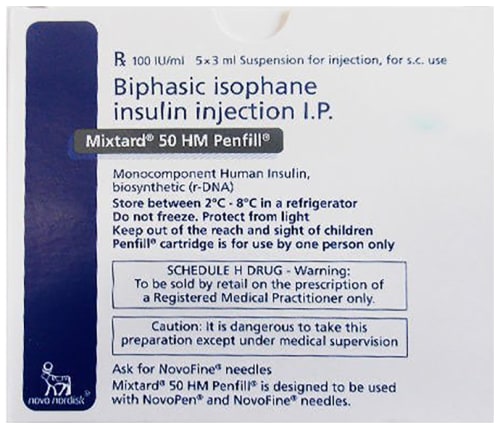

Insulin Isophane (50%)+ Human insulin (50%)
Mixtard 50 HM 100IU/ml Penfill (3ml Each) is normally prescribed along with other diabetes medicines. Your doctor or nurse will teach you the correct way of injecting it under the skin. It should be taken 15 minutes before a meal or within 20 minutes after starting a meal. Don’t stop taking it unless your doctor tells you to.It is only part of a treatment program that should also include a healthy diet, regular exercise, and weight reduction as advised by your doctor. Check your blood sugar levels regularly, keep track of your results and share them with your doctor. This is very important to work out the correct dose of the medicine for you.The most common side effect of this medicine is low blood sugar levels (hypoglycemia). To prevent this, it's important to always inject the correct dose of medicine only, have regular meals, and monitor your blood sugar levels regularly. Drinking excessive alcohol can also lead to a fall in your blood sugar levels. Other side effects include reactions at the injection site like redness or swelling. Some people gain weight while taking insulin. You may also notice a rash, edema (swelling), or itching while taking this medicine.Do not use this medicine when you have low blood glucose levels (hypoglycemia). Tell your doctor if you’ve ever had kidney, liver or heart problems before starting treatment. Pregnant or breastfeeding women should also consult their doctor as the dose may need to be changed.
Most side effects do not require any medical attention and disappear as your body adjusts to the medicine. Consult your doctor if they persist or if you’re worried about themCommon side effects of Mixtard
1 Suspension for Injection
Image shown is a representation and may slightly vary from the actual product. Every effort is made to maintain accuracy of all information displayed.
Your doctor or nurse will give you this medicine. Kindly do not self administer.
Insulin Isophane has a prolonged duration of action, while human insulin has a fast onset of action. Together, they ensure rapid and consistent sugar control by facilitating reuptake of sugar in muscle and fat cells and suppressing the production of sugar in the liver.
Related Warnings
It is unsafe to consume alcohol with Mixtard 50 HM 100IU/ml Penfill (3ml Each).
Mixtard 50 HM 100IU/ml Penfill (3ml Each) is generally considered safe to use during pregnancy. Animal studies have shown low or no adverse effects to the developing baby; however, there are limited human studies.
Mixtard 50 HM 100IU/ml Penfill (3ml Each) is safe to use during breastfeeding. Human studies suggest that the drug does not pass into the breastmilk in a significant amount and is not harmful to the baby.
Your ability to drive may be affected if your blood sugar is too low or too high. Do not drive if these symptoms occur.
Mixtard 50 HM 100IU/ml Penfill (3ml Each) should be used with caution in patients with kidney disease. Dose adjustment of Mixtard 50 HM 100IU/ml Penfill (3ml Each) may be needed. Please consult your doctor.
Regular monitoring of blood glucose levels is recommended for dose adjustment.
Mixtard 50 HM 100IU/ml Penfill (3ml Each) should be used with caution in patients with liver disease. Dose adjustment of Mixtard 50 HM 100IU/ml Penfill (3ml Each) may be needed. Please consult your doctor.
Regular monitoring of glucose levels is recommended for dose adjustment.
No, it is not safe to drink alcohol while using Mixtard 50 HM 100IU/ml Penfill (3ml Each). Drinking alcohol while using this medicine may lower your blood sugar levels and cause unexpected hypoglycemia.
Keep this medicine in the container or the pack it came in, tightly closed. Store it according to the instructions mentioned on the pack or label. Dispose of the unused medicine. Make sure it is not consumed by pets, children and other people.
Mixtard 50 HM 100IU/ml Penfill (3ml Each) is to be injected under the skin (subcutaneously). The best areas to give Mixtard 50 HM 100IU/ml Penfill (3ml Each) are your stomach, upper thigh, upper arm or buttocks.
Symptoms of high blood sugar include frequent urination, increased thirst, fatigue, nausea, vomiting, shortness of breath, stomach pain, fruity breath odor, dry mouth and a fast heartbeat.